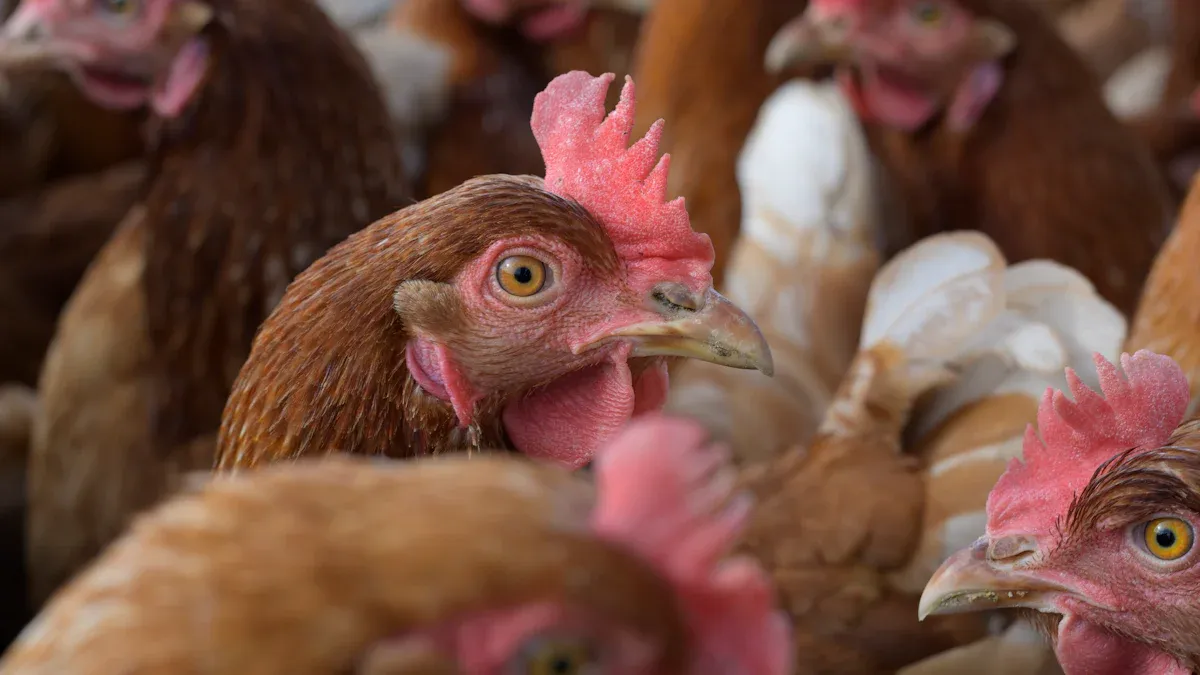
Have you noticed how poultryfarming is changing in the Middle East? Farmers are searching for sustainable feed options to meet growing demands. The numbers tell the story: the Meal Worms Feed Market, valued at 1.98 billion USD in 2023, is expected to hit 3.2 billion USD by 2032, with a steady 5.48% annual growth rate. That’s impressive, right?
Dried mealworms for poultry are leading this transformation. They’re not just a protein-packed alternative; they’re also improving feed efficiency. Studies show replacing soybean meal with mealworms can lower feed conversion rates while maintaining excellent nutrition. It’s a game-changer for farmers and their flocks.
Key Takeaways
- Dried mealworms are a protein-rich food with 51.93% protein.
- They help chickens grow faster and use food better.
- Mealworms improve eggs by making yolks richer and brighter.
- Farmers can sell these eggs for more money at markets.
- Using mealworms lowers costs and helps the environment.
- This makes chicken farming cheaper and better for the planet.
Nutritional Benefits of Dried Mealworms for Poultry
High Protein Content for Enhanced Growth and Productivity
Did you know that dried mealworms for poultry are packed with protein? They contain about 51.93% protein, which is higher than the 44.51% found in soybeans. That’s a big deal for farmers looking to boost their flock’s growth. Studies like those by Hussain et al. (2017) and Ballitoc and Sun (2013) show that mealworms improve growth performance and feed efficiency. Chickens grow faster and healthier when mealworms are part of their diet. Plus, the feed conversion ratio (FCR) improves, meaning less feed is needed for the same growth. This makes mealworms a smart choice for productivity and cost savings.
Essential Nutrients for Better Egg Quality and Yield
Egg production isn’t just about quantity; quality matters too. Mealworms have a rich amino acid profile, which is essential for feather development and egg production. Farmers who add mealworms to their poultry feed often notice eggs with richer yolks. These eggs not only look better but also fetch higher prices in the market. Research even shows that replacing traditional feed with mealworms can maintain or improve egg yield. It’s a win-win for farmers and consumers alike.
Boosting Poultry Health and Disease Resistance
Healthy chickens mean happy farmers. Dried mealworms for poultry don’t just help with growth; they also improve overall health. Studies like Benzertiha et al. (2020) and Islam and Yang (2016) found that mealworms enhance feed intake and alter gut microbiota. This leads to better digestion and stronger disease resistance. Healthier chickens are less likely to get sick, which means fewer losses for farmers.
Economic Advantages of Dried Mealworms for Poultry
Cost-Effectiveness and Long-Term Savings
Let’s talk about saving money. Dried mealworms for poultry are a cost-effective choice for farmers. Why? They’re cheaper to produce than traditional protein sources like soybean meal. Plus, they improve feed efficiency, so you get more growth for less feed. That’s a win for your wallet!
Here’s what research shows:
- Small-scale farmers in South Africa found that mealworms reduced their reliance on expensive protein sources like fishmeal.
- Using mealworms can lower transaction costs and boost farm income.
When you think about it, mealworms aren’t just a smart nutritional choice—they’re a smart financial one too.
Enhancing Market Competitiveness for Farmers
Want to stand out in the market? Mealworms can help. They’re not just good for your chickens; they’re good for your business. Farmers using mealworms can produce healthier, more sustainable poultry products. That’s a big sel
ling point in today’s market.
Take a look at these numbers:
| Metric | Value |
|---|---|
| Projected market value by 2030 | $1.27 billion |
| Compound annual growth rate (CAGR) | 25.8% (2022-2030) |
| Factors driving market growth | Rising GHG emissions, high nutritional value, environmental advantages, lower zoonotic disease risk |
Farmers who adopt mealworms are tapping into a growing market. It’s a chance to stay ahead of the competition and meet consumer demand for sustainable products.
Supporting Regional Economies with Sustainable Practices
Here’s the bigger picture: mealworms aren’t just good for individual farmers—they’re good for the economy. They’re a sustainable alternative to traditional feeds, which helps reduce environmental impact. Governments are even stepping in with financial incentives to support this shift.
By adopting mealworms, farmers can reduce their dependence on resource-heavy feeds like soybeans. This not only cuts costs but also promotes long-term economic stability in the agricultural sector. It’s a step toward a more sustainable future for everyone.
Environmental Impact of Dried Mealworms for Poultry
Lower Carbon Footprint Compared to Traditional Feeds
Have you ever thought about how much land and energy it takes to produce traditional poultry feed? It’s a lot. That’s where dried mealworms for poultry come in. They’re a game-changer for reducing the environmental footprint of farming.
Here’s what makes them special:
- Mealworms need less land to produce the same amount of protein compared to cattle, chicken, or pork.
- They emit fewer greenhouse gases like CO2 and methane.
- Their feed conversion efficiency rivals that of chickens, and they use nitrogen more effectively than cattle.
These benefits make mealworms a smart choice for farmers who care about the planet. By switching to mealworms, we can cut down on harmful emissions and make farming more sustainable.
Promoting Eco-Friendly and Sustainable Farming
I’ve noticed more farmers are turning to mealworms, and it’s not just about saving money. It’s about creating a better future. Mealworms help small-scale farmers move away from resource-heavy feeds like soybean and fishmeal. This shift promotes eco-friendly practices and supports local economies.
Take a look at these numbers:
| Metric | Value |
|---|---|
| Global warming potential (kg CO2-eq) | 20.4 |
| Non-renewable energy use (MJ-eq) | 213.66 |
| Agricultural land occupation (m²) | 22.38 |
| Terrestrial acidification potential (g SO2-eq) | 159.52 |
| Freshwater eutrophication potential (g P-eq) | 12.41 |
Farmers adopting mealworms are not just feeding their flocks—they’re helping the planet. It’s a win-win for everyone.
🌱 Tip: Switching to mealworms isn’t just good for the environment; it’s a step toward sustainable farming that benefits future generations.
Reducing Dependence on Resource-Intensive Feed Ingredients
Traditional feeds like soybean meal are expensive and resource-intensive. I’ve seen studies showing how dried mealworms for poultry can replace these feeds without sacrificing quality. For example:
- Mealworms improve growth efficiency and reduce feed conversion ratios in broilers.
- They can completely substitute soybean meal in diets without affecting taste or nutrition.
- Farmers using mealworms report lower costs and higher income.
This shift is huge. It means farmers can rely less on resource-heavy ingredients and focus on sustainable solutions. Mealworms are paving the way for a more efficient and eco-friendly poultry industry.
Market Trends in Dried Mealworms for Poultry in the Middle East
Increasing Adoption Rates Among Poultry Farmers
I’ve noticed more poultry farmers in the Middle East are turning to dried mealworms for poultry. Why? It’s simple—they’re seeing real results. Farmers tell me their chickens grow faster and healthier when mealworms are part of the diet. Plus, the long shelf life and easy storage make them a hassle-free option.
The shift isn’t just happening on small farms. Larger operations are also jumping on board. They’re replacing traditional feeds with mealworms to cut costs and improve efficiency. It’s exciting to see how quickly this trend is catching on.
Regional Growth and Investment in Alternative Proteins
The Middle East is becoming a hotspot for alternative proteins. Governments and private investors are pouring money into sustainable farming solutions. I’ve read about new facilities popping up to produce dried mealworms for poultry. These investments are creating jobs and boosting local economies.
What’s driving this growth? Farmers and consumers alike want eco-friendly options. Mealworms fit the bill perfectly. They’re sustainable, affordable, and packed with nutrition. It’s no wonder the region is leading the way in adopting this innovative feed.
Future Opportunities in the Mealworm Feed Market
The future looks bright for mealworms. As demand grows, I see opportunities for farmers and entrepreneurs. Imagine starting your own mealworm farm or developing new products for the poultry industry. The possibilities are endless.
Experts predict the market will keep expanding. That means more chances to innovate and grow. If you’re in the poultry business, now’s the time to explore what mealworms can do for you.
Dried mealworms for poultry are changing the game in Middle Eastern farming. They tackle nutritional, economic, and environmental challenges head-on. I see them as a key to a sustainable and competitive poultry industry. Innovative feed solutions like this aren’t just the future—they’re the present. Ready to make the switch?
FAQ
What makes dried mealworms better than traditional poultry feed?
Dried mealworms pack more protein and nutrients than traditional feeds like soybeans. They’re cost-effective, eco-friendly, and easy to store. Plus, chickens love them! 🐔
How do I store dried mealworms for poultry?
It’s simple! Keep them in a cool, dry place. No refrigeration needed. Their long shelf life makes them a hassle-free option for farmers.
Can dried mealworms replace all other poultry feed?
Not entirely. They work best as a supplement to balance nutrition. Mixing mealworms with other feed ensures your flock gets everything they need for optimal health and growth.
🐛 Tip: Start small! Gradually introduce mealworms into your poultry’s diet to see the benefits firsthand.


